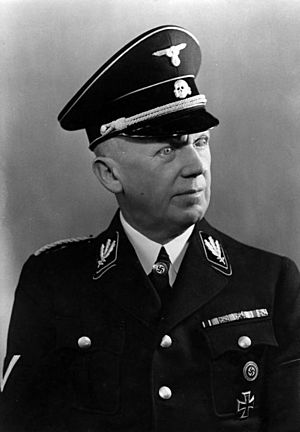Hans Lammers facts for kids
Quick facts for kids
Hans Lammers
|
|
|---|---|

Hans Lammers in SS uniform
|
|
| Chief of the Reich Chancellery | |
| In office 30 January 1933 – 24 April 1945 |
|
| Deputy | Friedrich Wilhelm Kritzinger (1942–45) |
| Leader | Adolf Hitler (Führer) |
| Preceded by | Erwin Planck |
| Succeeded by | Office abolished |
| Reichsminister without Portfolio | |
| In office 1 December 1937 – 24 April 1945 |
|
| Leader | Adolf Hitler (Führer) |
| President of the Reich Cabinet (Presiding Officer in Hitler's Absence) |
|
| In office January 1943 – 24 April 1945 |
|
| Personal details | |
| Born |
Hans Heinrich Lammers
27 May 1879 Lublinitz, Silesia, Prussia, German Empire |
| Died | 4 January 1962 (aged 82) Düsseldorf, West Germany |
| Political party | NSDAP |
| Other political affiliations |
DNVP until 1932 |
| Spouse |
Elfriede Tepel
(m. 1913; died 1945) |
| Children | 3 |
| Education | Law |
| Alma mater | German University of Breslau Heidelberg University |
| Profession | Judge |
| Cabinet | Hitler Cabinet |
| Military service | |
| Allegiance | |
| Branch/service | |
| Rank | SS-Obergruppenführer |
| Battles/wars | World War I |
| Awards | Iron Cross 1st Class Iron Cross 2nd Class |
Hans Heinrich Lammers (born May 27, 1879 – died January 4, 1962) was a German lawyer and a leading politician in the Nazi Party. From 1933 to 1945, he was the Chief of the Reich Chancellery under Adolf Hitler. After World War II, during a trial in 1948–1949, Lammers was found guilty of war crimes and crimes against humanity. He was sentenced to 20 years in prison.
Contents
Early Life and Career
Hans Lammers was born in Lublinitz, which is now Lubliniec in Poland. His father was a veterinarian. Lammers studied law at the universities of Breslau and Heidelberg. He earned his doctorate degree in 1904.
In 1912, he became a judge at a local court in Beuthen (now Bytom). During World War I, he served as a volunteer officer in the German Army. He was awarded the Iron Cross, First and Second Class, for his service. After the war, he joined the German National People's Party (DNVP). He continued his legal career and by 1922, he was an undersecretary in the Reich Ministry of the Interior.
Role in the Nazi Government
In 1932, Lammers joined the Nazi Party. He quickly rose through the ranks. In 1933, when the Nazis came to power, he became the State Secretary and Chief of the Reich Chancellery. This made him a key figure in the government.
He became the main contact and legal advisor for all government departments. In 1937, he joined Hitler's cabinet as a Reichsminister (a minister without a specific department).
Just before World War II began in August 1939, Hitler appointed Lammers to the six-person Council of Ministers for Defense of the Reich. This group acted like a "war cabinet." In this role, Lammers saw all important documents about national security and domestic policy before Hitler did. This made him one of the most powerful people in Nazi Germany. Many government officials believed Lammers spoke for Hitler himself.
Lammers was also one of the first officials to sign government letters with "Heil Hitler." This greeting soon became required for all civil servants. Not using it could be seen as a sign of disagreement and attract attention from the Gestapo, the secret police. In 1940, Lammers was given an honorary high rank in the SS, called SS-Obergruppenführer.
From January 1943, Lammers led cabinet meetings when Hitler was not there. He and Martin Bormann increasingly controlled who could see Hitler. In 1943, a committee of three was formed to manage the war economy. Its members were Lammers, Wilhelm Keitel (head of the Armed Forces High Command), and Bormann. This committee was supposed to make decisions quickly, but other ministers felt left out. They worked together to stop the committee, and it eventually lost its importance.
Over time, Lammers' power decreased. This was partly because of the war and partly because Martin Bormann gained more influence with Hitler.
Events of 1945
In April 1945, as World War II was ending, Lammers was arrested by SS troops. This happened during a time of confusion around Hermann Göring. On April 23, as Soviet forces surrounded Berlin, Göring, Lammers, and General Karl Koller discussed the situation. They agreed that Göring was Hitler's chosen successor and should act as his deputy if Hitler could no longer lead.
Göring believed Hitler was unable to govern by staying in Berlin. He sent a telegram from Berchtesgaden, saying he would take over leadership of Germany. However, Martin Bormann intercepted the telegram. He convinced Hitler that Göring was a traitor. Hitler became angry and ordered Göring's arrest. Hitler then removed Göring from all his positions. Göring, his staff, and Lammers were placed under house arrest.
Postwar and Later Life
After the war, Lammers shared information with Allied investigators about how the Nazi government worked. He explained that high-ranking officials and military leaders received special benefits and large cash awards.
In April 1946, Lammers was a defense witness at the Nuremberg trials. In April 1949, he was tried in the Ministries Trial, one of the later Nuremberg trials. He was sentenced to 20 years in prison. Later, his sentence was reduced to 10 years, and he was released from Landsberg Prison in January 1951.
Hans Lammers died on January 4, 1962, in Düsseldorf. He was buried in Berchtesgaden with his wife and daughter.
See also
 In Spanish: Hans Heinrich Lammers para niños
In Spanish: Hans Heinrich Lammers para niños


